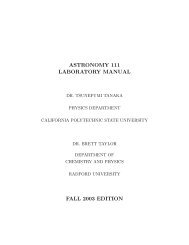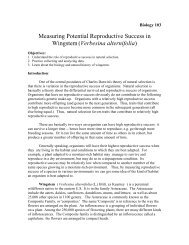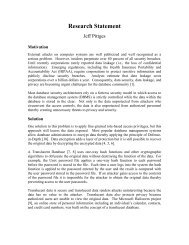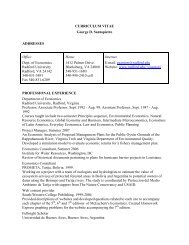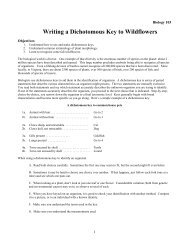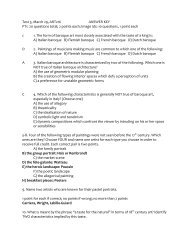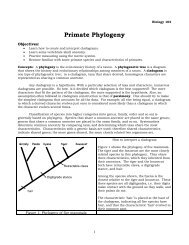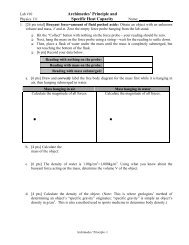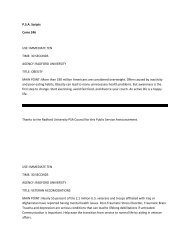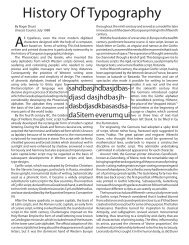lab 9
lab 9
lab 9
Create successful ePaper yourself
Turn your PDF publications into a flip-book with our unique Google optimized e-Paper software.
Lab #9<br />
Hooke’s Law and the<br />
Physics 111 Simple Pendulum Name:<br />
I. Hooke’s Law: F = k Δx<br />
= k x − x ) = k(<br />
x − )<br />
spring<br />
(<br />
0<br />
x unstretche d<br />
A. The drawing shows a stationary mass hanging from a hypothetical<br />
spring with linear behavior governed by Hooke’s Law.<br />
ceiling<br />
x 0<br />
x<br />
[4 pts] Draw the free body diagram for<br />
the mass. Correctly <strong>lab</strong>el all forces on<br />
your free body diagram.<br />
Δx=17cm<br />
[4 pts] If the mass of the block is 250g, find the spring constant of the spring in units of<br />
Newtons/cm.<br />
B. The brass spring at your table exhibits the full range of spring behavior, including non-linear<br />
behavior. You’re going to use the computer interfaces to investigate this behavior.<br />
The spring at your table is called a “zero-length” spring. These springs have a tension on them<br />
even with no stretch. This is an example of non-linear behavior.<br />
x 0<br />
<br />
For this part of the <strong>lab</strong>, do the following:<br />
Start with the spring on the table with no tension on it.<br />
T<br />
<br />
<br />
<br />
<br />
<br />
<br />
“Zero” the force probe with it touching nothing.<br />
On the table, use chalk to mark the initial position x 0 of the end of the spring. Then, mark<br />
every 4.0cm beyond that to at least 50cm.<br />
Use the force probe to pull the spring out to various lengths Δx.<br />
Hold these in place for a couple of seconds so the computers can record the spring force.<br />
Stretch the springs out until you reach Δx~48cm.<br />
Use your data to fill out the table on the next page. NOTE: The units of the spring constant<br />
“k” will be Newtons/cm. You should only have 2 significant figures for “k.”<br />
Hooke’s Law & the Simple Pendulum HW–1
Lab #9<br />
Hooke’s Law and the<br />
Physics 111 Simple Pendulum Name:<br />
Stretch Δx(cm)<br />
x 1 = 0.0<br />
Force (N)<br />
F 1 = 0.0 N<br />
x 2 = 4.0 F 2 = k=(F 2 –F 1 )/(x 2 –x 1 )=<br />
x 3 = 8.0 F 3 = k=(F 3 –F 2 )/(x 3 –x 2 )=<br />
12<br />
16<br />
20<br />
24<br />
28<br />
32<br />
36<br />
40<br />
44<br />
48<br />
Data Table [15 pts]<br />
Spring constant k=ΔF/Δx (N/cm)<br />
(2 significant figures)<br />
[6 pts] On the graph provided to the<br />
right, plot your values for F and Δx.<br />
F (Newtons)<br />
These “zero length” springs have some<br />
initial tension built into them so their<br />
“resting state” is contracted. Once you<br />
get these springs stretched out just a<br />
little way, they act like traditional<br />
springs with a spring constant.<br />
[2 pts] What trend do you notice with<br />
your graph?<br />
0<br />
0<br />
Δx (cm)<br />
[2 pts] Approximately how far do you have to stretch<br />
the spring until it behaves like the traditional springs<br />
discussed in class?<br />
[2 pts] What value does the spring constant settle into?<br />
Hooke’s Law & the Simple Pendulum--2
Lab #9<br />
Hooke’s Law and the<br />
Physics 111 Simple Pendulum Name:<br />
II. The simple pendulum—simple harmonic motion example<br />
Set the photogate timers on “pend” and the timing accuracy (on their undersides) to “1ms.”<br />
Put a 100g mass on your string. Make the length of your string L=1.0 meter.<br />
A. [8 pts] Use the initial amplitudes listed below and determine the period of oscillation for each.<br />
Keep your length and mass constant.<br />
Amplitude A<br />
very small (~5cm)<br />
small (~10cm)<br />
medium (~15cm)<br />
large (~20cm)<br />
very large (~25cm)<br />
Period T (sec)<br />
Does the amplitude affect the period of oscillation of a pendulum? yes no (circle one)<br />
B. [8 pts] Use the masses listed below and determine the period of oscillation for each.<br />
Mass m<br />
50g<br />
100g<br />
200g<br />
500g<br />
Period T (sec)<br />
Does the mass on the pendulum affect the period of oscillation of a pendulum? yes no<br />
C. [8 pts] Use the string lengths listed below and determine the period of oscillation for each.<br />
For each of these,<br />
pay attention to<br />
large differences<br />
only.<br />
Length L<br />
40 cm<br />
60 cm<br />
80 cm<br />
100 cm<br />
120 cm<br />
Period T (sec)<br />
Does the length affect the period of oscillation of a pendulum? yes<br />
no<br />
As you have seen, not all of the variables of mass m, string length L and amplitude A come into play<br />
with the period of a pendulum. Oddly enough, the variables that you might suspect “surely would”<br />
determine the period of the pendulum have no effect. Thus, any equation that describes a simple<br />
pendulum should reflect that some variables matter while others don’t.<br />
Hooke’s Law & the Simple Pendulum--3
Lab #9<br />
Hooke’s Law and the<br />
Physics 111 Simple Pendulum Name:<br />
The period T and length L of a simple pendulum are related by the equation<br />
2<br />
2 4π L<br />
T = .<br />
g<br />
Here, g is the gravitational acceleration at the location of the pendulum. This assumes the oscillations<br />
have settled down into a consistent rhythm, and the amplitude of the oscillations is not too large. (The<br />
phrase “amplitude…not too large” means not more than about 20 0 away from the vertical.)<br />
[8 pts] Use your data with the various lengths on the previous page to calculate g for all 5 cases. Show<br />
your work for all 5 cases below. Your answers should have 3 significant figures.<br />
L=<br />
L=<br />
L=<br />
L=<br />
L=<br />
T=<br />
T=<br />
T=<br />
T=<br />
T=<br />
If any of your calculations indicate problems with the data, it is legitimate to throw out that point.<br />
[3 pts] Take the average of your values above for g: g = .<br />
[3 pts] How does your average value compare to the value of g=9.8 m/s 2 we so often use in class?<br />
Hooke’s Law & the Simple Pendulum--4



